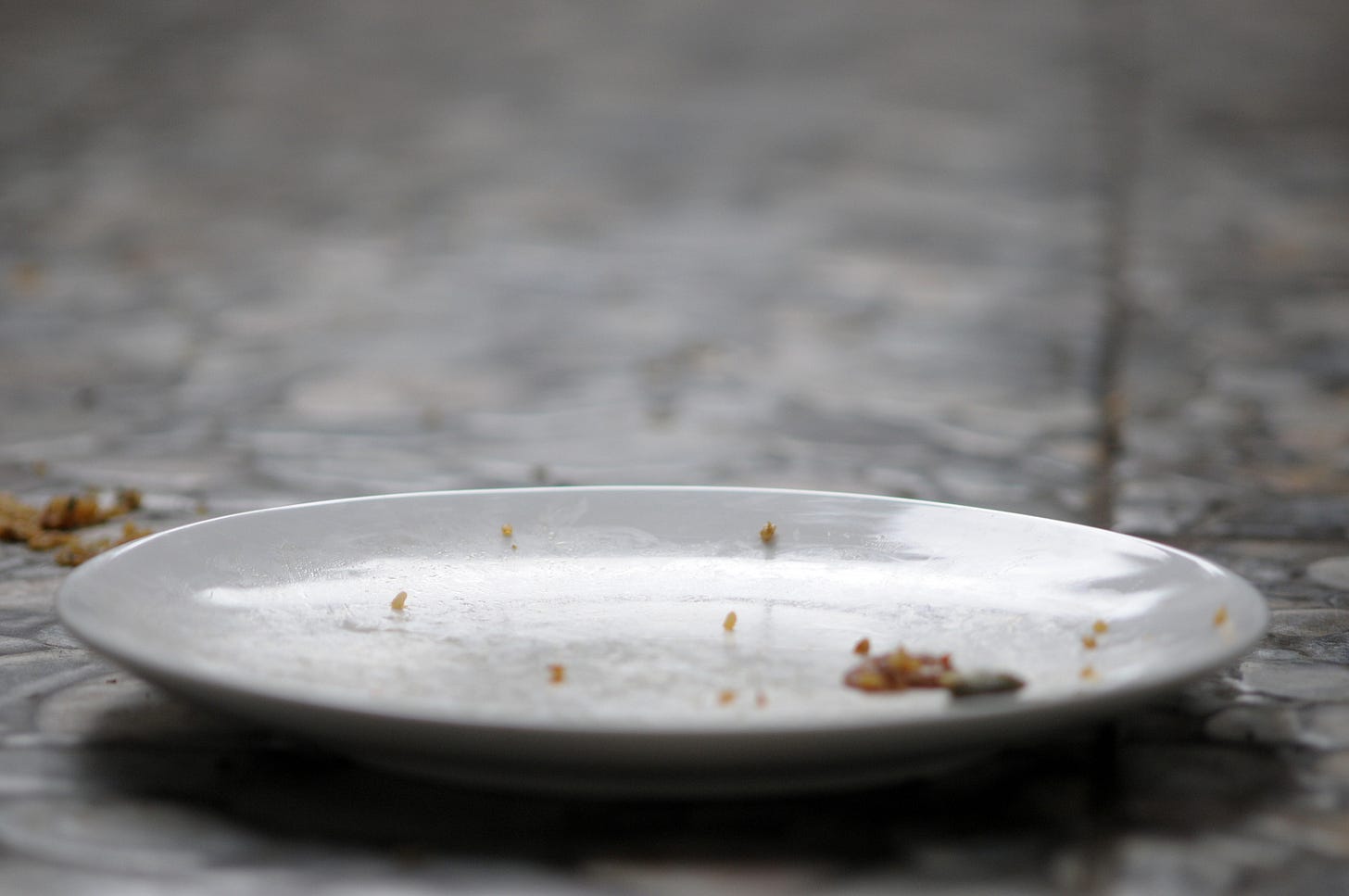Starvation As Strategy
How the powerful weaponise Food... and get away with it
First off, thanks for sending such thoughtful answers to my question about impact and how to get news to a more mainstream audience. I promise to respond properly. It’s just that I had 20 calls over the past four days, in addition to the researching and reporting that are key parts of my job.
This week’s issue is all about power, especially the power to use food as a weapon of war.
Of course, talking about power in food systems - or power in general - isn’t complete if we don’t talk about the Global North’s role in abetting, neglecting, and choosing to be selectively-outraged about by who’s weaponising food. The U.S. deserves a special mention here.
An unrelated fun fact: I can no longer travel to the U.S. to see family! Granted, I did tell them months ago that for the foreseeable future, they’d have to cross the pond to see me. I just don’t have the right skin colour or passport to feel confident about going there.
When the UN Security Council unanimously adopted the landmark Resolution 2417 in May 2018, it signalled that the oft-squabbling members acknowledged the link between conflict and hunger and it is unacceptable to use food as a weapon of war.
The resolution includes these lines:
“Underlining that using starvation of civilians as a method of warfare may constitute a war crime”
“Strongly condemns the use of starvation of civilians as a method of warfare in a number of conflict situations and prohibited by international humanitarian law”
“Strongly condemns the unlawful denial of humanitarian access and depriving civilians of objects indispensable to their survival, including wilfully impeding relief supply and access for responses to conflict‑induced food insecurity in situations of armed conflict, which may constitute a violation of international humanitarian law”
Look, I’m not naive. I didn’t expect all parties in a war to suddenly respect international humanitarian law, but to see the permanent members of the Security Council actively break their own resolution within just a few years of its adoption is another matter.
A quintet of statements from the UN over the past few weeks give an idea of how bad the situation has become in a number of countries, including my own.
Also, let’s be clear about one thing from the outset. The terrible situation in these countries has very little to do with whether we are producing enough food.
According to the latest Food Outlook report from the FAO, we’re expecting an increase in production in 2025 of most key crops, with cereals probably reaching a record level, and meat, dairy, and fisheries all projected to expand output.
“As of April 2025, more than 80 percent of the Gaza Strip’s total cropland area has been damaged and 77.8 percent is not accessible to farmers, leaving just 688 hectares available for cultivation,” said the FAO, which came to this conclusion after using high-resolution satellite imagery and comparing that against pre-conflict baselines.
“The situation is particularly critical in Rafah and in the northern governorates, where nearly all cropland is not accessible.”
It also found that 71% of greenhouses and nearly 83% of agricultural wells have been damaged.
Less than two weeks after this assessment came a new Food Security Phase Classification (IPC) analysis on Jun 5 which said the entire population of the Gaza Strip (emphasis mine) is facing “a critical risk of famine” in the coming months.
I’m sharing the following paragraphs in full because they portray how horrifying the situation is.
“All 25 bakeries supported by the World Food Programme (WFP) closed at the beginning of April due to lack of supplies, and food stocks for most of the 177 hot meal kitchens are reportedly exhausted. All preventive nutrition supplies have run out in UNICEF and WFP warehouses. Food prices are soaring daily, with wheat flour ranging from USD $235 per 25 kg in Deir al-Balah to USD $520 in Gaza and Khan Younis - a 3,000 percent increase since February 2025. Latest data show many households resorting to extreme coping strategies. A third reported collecting garbage to sell for food, while a quarter indicated that no valuable garbage remains. Observations reveal that social order is breaking down.”
“The plan announced on 5 May by Israeli authorities for delivering food and non-food items across the governorates is estimated to be highly insufficient to meet the population’s essential needs for food, water, shelter and medicine. Moreover, the proposed distribution mechanisms are likely to create significant access barriers for large segments of the population. In light of the announced large-scale military operation across the Gaza Strip and the persistent inability of humanitarian agencies to deliver essential goods and services, there is a high risk that Famine (IPC Phase 5) will occur in the projection period (11 May – 30 September). The latest announcements suggest that this worst-case scenario is becoming more likely.”
Meanwhile, the Gaza Humanitarian Foundation (GHF), which has the backing of the Israeli and U.S. governments but none from experienced humanitarian actors, continues its controversial operations despite losing its head and consultants in recent weeks.
Reuters reported today (Jun 13) that Israel allowed humanitarian trucks carrying supplies from the World Food Programme to enter northern Gaza directly overnight. That is a minuscule piece of good news, but even that is dampened by comments from Mike Huckabee, the American ambassador to Israel, suggesting “Muslim countries” set up a Palestinian state in their territories.
The situation in Ukraine is a bit different in two ways:
Many world leaders have publicly and repeatedly denounced Russia’s attempts to choke Ukraine through attacks on infrastructure critical for agriculture and grain trade, and,
Ukraine has received significant funding (80% of the UN humanitarian response plan for 2024) compared to many other countries.
Nevertheless, Russia’s bombardment has been so relentless it has severely affected the country’s ability to produce food. Total damage in the agriculture sector amounts to $11.2 billion, while losses amount to $72.7 billion, the World Bank, the Ukrainian government, the EU, and the UN said in an assessment published earlier this year.
The total recovery and reconstruction needs is estimated at $55.5 billion over 10 years. These numbers do not include damages and losses associated with irrigation and water resources that are critical for food production, nor the costs of rebuilding them.
The war also had knock on effects on the rest of the world, pushing up global food prices (although some used this as a cover to enrich themselves) and worsening food insecurity in countries relying on imports from Ukraine.
Now the FAO is warning that many Ukrainian farmers and rural farming families face limited access to their land due to mines and lack the financial resources to purchase needed agricultural inputs.
“Across the country, rural households – many of them elderly- or female-headed – continue to depend on agriculture for their survival. They are growing vegetables, tending to a single cow or a handful of chickens, and cultivating small plots of land – often under shelling, without reliable electricity, and with limited access to markets and supplies. What used to be a routine part of their work is now life-threatening in some regions.”
“Without urgent and sustained support, thousands of rural households may be unable to plant or harvest on time – jeopardising national food security and rural livelihood.”
Famine has already hit parts of Sudan, with a record-high number of over 600,000 people facing “catastrophic hunger” and about half of the population - nearly 25 million - experiencing acute food insecurity (ranging from not eating enough with high levels of malnutrition, to becoming sick due to a lack of food, to starving).
In December, Reuters published a great piece explaining how renewed violence caused famine in displaced communities in 2023. It also pointed out the limitations of the IPC system against a government - and an opposition - determined to restrict aid flows to each other.
The war, which erupted in April 2023 between the Sudanese Armed Forces (SAF) and the paramilitary Rapid Support Forces (RSF), has triggered a full-blown humanitarian catastrophe, the U.N. has said.
Foreign stakeholders have played key roles in the conflict, according to observers, with the UAE accused of being an important supporter of the RSF. There are concerns too that the war in Sudan is merging with conflicts in South Sudan, its southern neighbour, which will exacerbate hunger in both countries.
Conflict is also increasing the risk of famine in parts of South Sudan, with 7.7 million people - 57% of the population - experiencing high levels of acute food insecurity and 2.3 million children at risk of acute malnutrition, according to the latest IPC analysis.
Limited, restricted, or a complete lack of access to humanitarian aid due to fighting was identified as a key driver of both hunger and malnutrition in the world’s youngest country, which has been riven by a civil war since independence in 2011.
“Humanitarian access in the conflict-affected areas remains severely constrained, leaving vulnerable communities without vital support during the lean season, amid ongoing conflict and displacement,” the assessment said.
“In the absence of a lasting political settlement in Juba, and with continued hostilities in Sudan, conflict will continue to be one of the key determining drivers of food insecurity and malnutrition throughout the projection period.”
Aid agencies, rights groups, and religious leaders have accused the warring parties of repeatedly using food as a weapon, with some incidents dating back nearly a decade.
After four and a half years of brutal military rule, many parts of my country are in ruins and the people are struggling to feed themselves, a group of UN human rights experts said recently.
“As the junta continue to lose territory to armed resistance groups, it has retaliated by blockading aid, and restricting humanitarian access, limiting trade routes, and targeting humanitarian workers, further compounding an already dire food crisis.”
“Furthermore, the Myanmar military’s attacks have destroyed agricultural equipment, and contaminated farmland with landmines and unexploded ordnance, exacerbating challenges for local food production. Even where arable land exists, there is a shortage of workers due to massive displacement and people fleeing conscription by the military.”
Their warning came months after a UNDP report that said Rakhine State in western Myanmar “is on the verge of an unprecedented disaster” and faces “the imminent threat of acute famine”, where “over 2 million people are at risk of starvation”.
There, fierce fighting between the Arakan Army and the junta has led to mass displacement as well as the destruction of rice crops and food stores. The latter has also blocked almost all humanitarian aid into the state since 2023.
Even before the coup, Rakhine was one of the poorest and least developed states in Myanmar and the site of some of the worst ethnic riots in the country, where successive military leaders have stoked ethnic tensions and encouraged the persecution of the Muslim Rohingya minority.
Russia, China, and India are key enablers of the Myanmar regime, while neighbouring Southeast Asian countries have been ineffectual at best or complicit at worst.
As recently as August 2023, 91 countries signed a joint communiqué condemning the use of food as a weapon of war. It was led by the U.S. and Israel was a signatory. It is impossible to imagine the U.S. leading anything similar these days, even if it were all for show. The same with the Israeli government.
“In the response… to the invasion of Ukraine and especially in the case of Gaza, we have seen how food has been blatantly weaponised with very, very little protest,” Jomo Kwame Sundaram, a Malaysian economist and member of IPES-Food, said at a recent webinar I moderated.
“So we have seen a deterioration of the very ethics of human existence itself and especially as it involves food has been very severely undermined in recent times.”
Jomo’s words reminded me of the febrile environment in Myanmar in the aftermath of the Aug 2017 attack against police posts by the Arakan Rohingya Salvation Army (Arsa). The military’s subsequent crackdown caused 730,000 Rohingya to flee across the border in what the U.N. human rights commissioner called “a textbook example of ethnic cleansing”.
Not long after the military operation started and as international condemnation mounted, I received an email from a Burmese defending the mass killings of the Rohingya. In her words, every single Rohingya including women and children should be killed and deserved to die because they are all terrorists and support ARSA.
I don’t remember the exact details of the email - I deleted it almost as immediately - but I vividly remember the blind hatred against a community she did not know and possibly has never even met. It was so palpable I felt physically sick reading it.
That same blind hatred must be driving the Israeli officials, the Russian government, the Sudanese warring parties, and the Myanmar military, to commit one of the worst kinds of crime: the deliberate starvation of a group of people.
But what about us and the leaders of the supposed free world? The lack of care and concern, especially towards what’s happening in Gaza, is completely unfathomable.
Are we really lacking in such humanity that we cannot acknowledge what’s happening? Have we really become so simple that we cannot both condemn the attack by Hamas as well as what the Israeli government is doing?
The right to food is a fundamental and universal human right. We should treasure it, respect it, and protect it. We should also call it out when anyone is violating it.
Thin’s pickings
Top 10 agribusiness giants: corporate concentration in food & farming in 2025 - ETC Group & GRAIN
A follow up to Food Barons 2022 report, which Thin Ink covered, this one analysed the state of corporate concentration in six sectors critical to agriculture: commercial seeds, pesticides, synthetic fertilisers, farm machinery, animal pharmaceuticals and livestock genetics.
“Corporate consolidation has increased in most of these sectors and four of them - seeds, pesticides, agricultural machinery and animal pharmaceuticals - meet the definition of an oligopoly, in which four companies control more than 40% of a market.”
A great resource for anyone interested in this topic.
Free trade agreement with Malaysia: Switzerland imperils the rights to food and health - Public Eye
Six Swiss NGOs are raising their concerns over the upcoming FTA to be signed between the European Free-Trade Association (EFTA) states – which includes Switzerland – and Malaysia, based on a leak of documents around the protection of intellectual property.
“The EFTA states are calling on Malaysia to become part of the 1991 UPOV convention. This would severely restrict small-scale farmers’ free exchange of seeds,” the NGOs said.
Their open letter is here. The issue of Thin Ink focusing on UPOV is here.
Fossil fuel billionaires are bankrolling the anti-trans movement - Heated
Intersectionality is an unwieldy term but a crucial lens for anyone interested in living in a fairer world. This guest piece by Yessenia Funes explains why the struggle is a collective one.
A Killer Within Easy Reach - The New York Times
On how suicide in many countries are linked to the easy access to pesticides, with a case study on Suriname, where a majority of deaths are linked to paraquat, a weed killer that has also been linked to Parkinson’s.
If you want to know more about paraquat, my colleague Margot and Elena led an investigation last year into a PR firm linked to this pesticide.
As always, please feel free to share this post and send tips and thoughts on bluesky @thinink.bsky.social, mastodon @ThinInk@journa.host, my LinkedIn page, or via e-mail thin@thin-ink.net.










